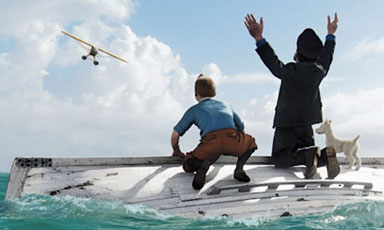|
The hottest in cinema and television:
Is 3D the medium of the future?
Steven Spielberg's film The Adventures of Tintin is just the latest
3D hit, watched by millions around the world. Photograph:
Columbia/Paramount
Steven Spielberg's 3D film The Adventures of Tintin took £25.5m in
ticket sales around the world. And 3D is also entering homes, via
expensive TV sets. Proponents of the format claim it is the future of
media viewing. But, according to Owen Weetch, of the University of
Warwick, 3D isn't always worth the extra cash or spectacle-wearing and
only some genres and films are improved by the format.
|

Steven Spielberg’s film The Adventures of Tintin is the latest
3D hit, watched by millions around the world. Photograph:
Columbia/Paramount |
"I started to investigate 3D cinema about six months before Avatar
was released, when there was a great deal of advance publicity keen to
tout 3D as the future of cinema, comparable to the introduction of sound
or colour," says Weetch. "I was interested in whether this would be the
case, or if it would simply be 'the emperor's new clothes'."
Watching films or researching other criticism and analysis of 3D,
Weetch noticed a lot of condemnation of the format. "Critics such as
Roger Ebert and Mark Kermode are opposed," he says, "and a recent study
by L Mark Carrier of California State University suggests that the
medium produces headaches, eyestrain and trouble with vision and 'there
aren't any benefits in terms of understanding the movie better'." Weetch
disagrees. Some films are well worth the effort of 3D, he says.
"In my research I investigate specific genres and how previous
alterations to the cinematic image's width and depth - such as deep
focus and wider screens - have impacted on those genres'
representational strategies. Genres that in some way depend on the space
or environment in which their stories take place certainly do benefit -
exponentially - from the additional dimension."
Take Avatar, the 3D James Cameron-directed blockbuster that smashed
all records to become the fastest movie ever to achieve $1bn in world
ticket sales . "It's a science fiction spectacular about humans engaging
with a new, alien space," says Weetch, "so a stereoscopic [3D] staging
that emphasises deep space guides the audience into the story world.
This aligns the viewer more forcefully with the protagonists, who are
themselves exploring this space, and so heightens the immersive thrill
of the story."
Horror films are another genre where it is worth paying for 3D,
Weetch believes. "They have traditionally seized on the dark shadows at
the edge of the frame to scare their audiences and 3D can use its
extension of screen space to create unprecedented dark spaces, out of
which threats might leap. The object of terror might have been hiding
right in front of your nose while you've been scanning the distance."
Scary stuff - but not as terrifying as the academic's musings on Jackass
3D.
"When a film's focus is on bodies moving through space, as in
musicals, dance films and slapstick comedy, the impression of that
movement becomes more palpable in 3D," Weetch says. Some film-makers use
3D as an excuse to forego other, potentially more important parts of a
viewer's experience, Weetch adds. He flags up the example of Sanctum,
this year's 3D underwater adventure. "It made an honest attempt to
engage with the aesthetic of depth, but was let down elsewhere, by rote
storytelling or ineffectual direction.
While 3D is one of many textual strategies that can contribute to
thematic and narrative unity, it isn't necessarily effective on its
own." Some filmmakers, Weetch adds, exploit viewers: "they think they
can make money by foisting depth on to something shallow, and it simply
doesn't work that way."
In the context of funding cuts to academia and questions over "Mickey
Mouse degrees", Weetch admits he does face accusations that the films he
studies are "not exactly serious or particularly highbrow."
But that, he says, "presumes that 3D can't contribute to films that
are concerned with characters and ideas, which I'd attribute to
ignorance and snobbery.
Tintin, The Hole in 3D, and Kung-Fu Panda 2 all contain
psychoanalytic sequences where characters retreat mentally into their
past, and 3D layering expressively portrays the inner workings of their
minds."
- The Guardian
|

